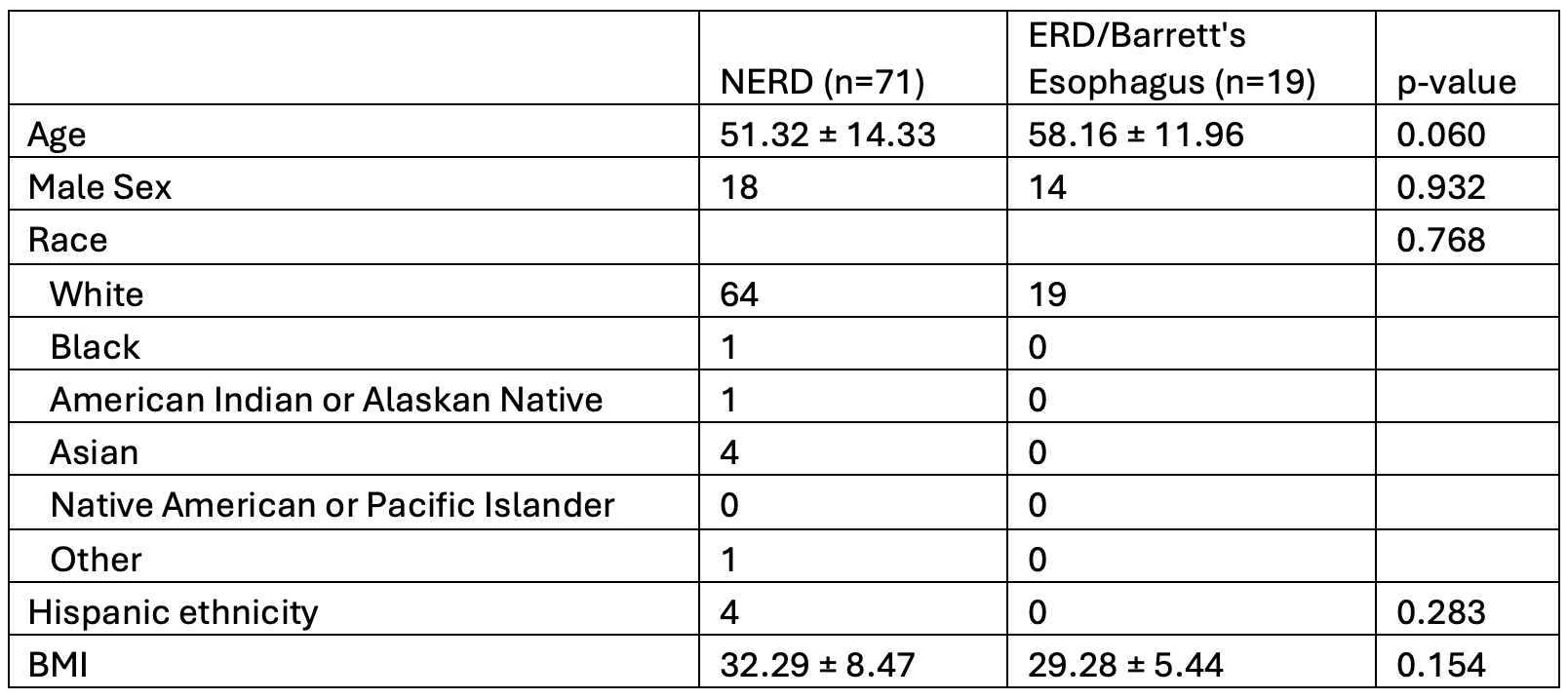Tuesday Poster Session
Category: Esophagus
P4954 - Contemporary Frequency of Non-Erosive Reflux Disease in Symptomatic Patients
Tuesday, October 28, 2025
10:30 AM - 4:00 PM PDT
Location: Exhibit Hall
- KL
Katie Liu, MD
University of Michigan
Ann Arbor, MI
Presenting Author(s)
Bhavana Tetali, MD1, Katie Liu, MD1, Charlotte Larson, MD2, Vamshek Srinivasan, MD, MBA1, Eric D. Shah, MD, MBA3
1University of Michigan, Ann Arbor, MI; 2University of Washington, Seattle, WA; 3Division of Gastroenterology and Hepatology, University of Michigan, Ann Arbor, MI
Introduction: Heartburn affects nearly 20% of individuals in the United States. When left untreated, chronic heartburn due to gastroesophageal reflux disease (GERD) can lead to esophageal mucosal injury, classified as erosive reflux disease (ERD). However, with the widespread availability and use of proton pump inhibitors (PPIs) over the past few decades, such presentations have become less common. Increasingly, many patients with reflux symptoms exhibit no visible mucosal damage on endoscopy – a presentation known as non-erosive reflux disease (NERD). This study aims to characterize the contemporary prevalence of NERD among symptomatic patients.
Methods: This was a prospective, observational, single-center, IRB-approved study that included patients undergoing an upper endoscopy (EGD) to evaluate heartburn between February 2024 to May 2025. Demographics and BMI were collected through chart review. Participants were divided into 2 groups: those with NERD, and those with erosive disease (ERD) or Barrett’s esophagus. Data were analyzed using descriptive statistics, 2-sample t-tests and chi-square analyses.
Results: A total of 90 patients were included. Of these, 78% (71/90) had normal esophageal mucosa consistent with NERD. LA grade A and B esophagitis were identified in 10% (9/90) and 6% (5/90) of patients respectively. LA grade C and D esophagitis were identified in 3% (3/90) of and 0% (0/90) of patients respectively. Barrett’s esophagus or short-segment Barrett’s was found in 2% (2/90). There were no significant differences in demographic characteristics or BMI between groups (Table 1).
Discussion: In this prospective study, the majority (78%) of patients undergoing endoscopic evaluation for heartburn had no visible esophageal mucosal injury, consistent with NERD. These findings highlight NERD as the predominant presentation of GERD in current day clinical practice – a critical distinction, as its management is quite different from ERD, and focuses on symptom relief rather than mucosal healing. These results underscore the high prevalence of NERD in the current clinical environment and support the need for further research into therapies for this group of patients. The authors would like to disclose the use of ChatGPT to improve language and readability of this abstract.

Figure: Table 1: Demographics in patients with NERD vs ERD/Barrett’s Esophagus
Disclosures:
Bhavana Tetali indicated no relevant financial relationships.
Katie Liu indicated no relevant financial relationships.
Charlotte Larson indicated no relevant financial relationships.
Vamshek Srinivasan indicated no relevant financial relationships.
Eric Shah: Ardelyx – Consultant. Mahana Therapeutics – Consultant. NeurAxis – Consultant. Salix Pharmaceuticals – Consultant. Takeda Pharmaceuticals – Consultant. University of Michigan – Intellectual Property/Patents.
Bhavana Tetali, MD1, Katie Liu, MD1, Charlotte Larson, MD2, Vamshek Srinivasan, MD, MBA1, Eric D. Shah, MD, MBA3. P4954 - Contemporary Frequency of Non-Erosive Reflux Disease in Symptomatic Patients, ACG 2025 Annual Scientific Meeting Abstracts. Phoenix, AZ: American College of Gastroenterology.
1University of Michigan, Ann Arbor, MI; 2University of Washington, Seattle, WA; 3Division of Gastroenterology and Hepatology, University of Michigan, Ann Arbor, MI
Introduction: Heartburn affects nearly 20% of individuals in the United States. When left untreated, chronic heartburn due to gastroesophageal reflux disease (GERD) can lead to esophageal mucosal injury, classified as erosive reflux disease (ERD). However, with the widespread availability and use of proton pump inhibitors (PPIs) over the past few decades, such presentations have become less common. Increasingly, many patients with reflux symptoms exhibit no visible mucosal damage on endoscopy – a presentation known as non-erosive reflux disease (NERD). This study aims to characterize the contemporary prevalence of NERD among symptomatic patients.
Methods: This was a prospective, observational, single-center, IRB-approved study that included patients undergoing an upper endoscopy (EGD) to evaluate heartburn between February 2024 to May 2025. Demographics and BMI were collected through chart review. Participants were divided into 2 groups: those with NERD, and those with erosive disease (ERD) or Barrett’s esophagus. Data were analyzed using descriptive statistics, 2-sample t-tests and chi-square analyses.
Results: A total of 90 patients were included. Of these, 78% (71/90) had normal esophageal mucosa consistent with NERD. LA grade A and B esophagitis were identified in 10% (9/90) and 6% (5/90) of patients respectively. LA grade C and D esophagitis were identified in 3% (3/90) of and 0% (0/90) of patients respectively. Barrett’s esophagus or short-segment Barrett’s was found in 2% (2/90). There were no significant differences in demographic characteristics or BMI between groups (Table 1).
Discussion: In this prospective study, the majority (78%) of patients undergoing endoscopic evaluation for heartburn had no visible esophageal mucosal injury, consistent with NERD. These findings highlight NERD as the predominant presentation of GERD in current day clinical practice – a critical distinction, as its management is quite different from ERD, and focuses on symptom relief rather than mucosal healing. These results underscore the high prevalence of NERD in the current clinical environment and support the need for further research into therapies for this group of patients. The authors would like to disclose the use of ChatGPT to improve language and readability of this abstract.

Figure: Table 1: Demographics in patients with NERD vs ERD/Barrett’s Esophagus
Disclosures:
Bhavana Tetali indicated no relevant financial relationships.
Katie Liu indicated no relevant financial relationships.
Charlotte Larson indicated no relevant financial relationships.
Vamshek Srinivasan indicated no relevant financial relationships.
Eric Shah: Ardelyx – Consultant. Mahana Therapeutics – Consultant. NeurAxis – Consultant. Salix Pharmaceuticals – Consultant. Takeda Pharmaceuticals – Consultant. University of Michigan – Intellectual Property/Patents.
Bhavana Tetali, MD1, Katie Liu, MD1, Charlotte Larson, MD2, Vamshek Srinivasan, MD, MBA1, Eric D. Shah, MD, MBA3. P4954 - Contemporary Frequency of Non-Erosive Reflux Disease in Symptomatic Patients, ACG 2025 Annual Scientific Meeting Abstracts. Phoenix, AZ: American College of Gastroenterology.
